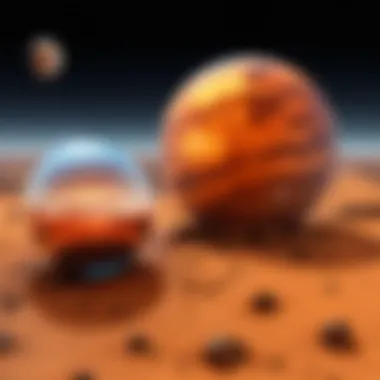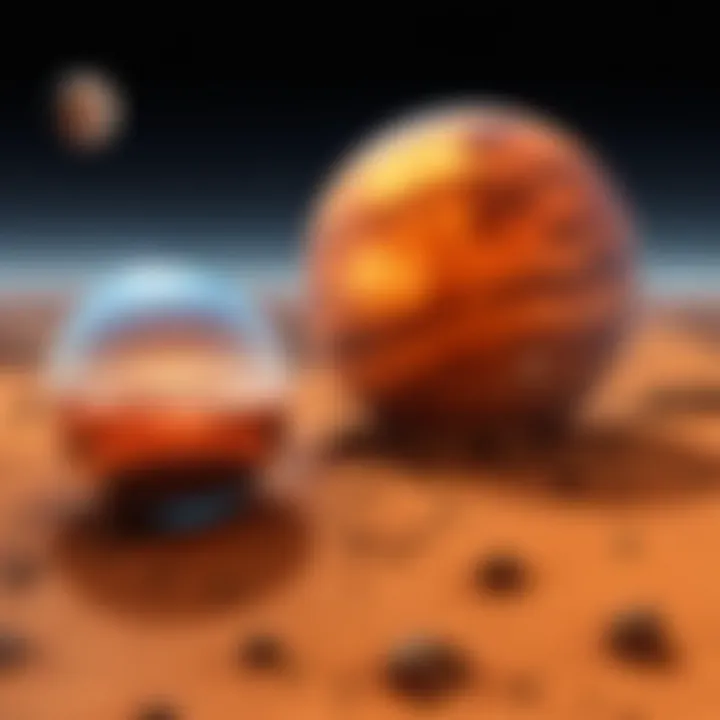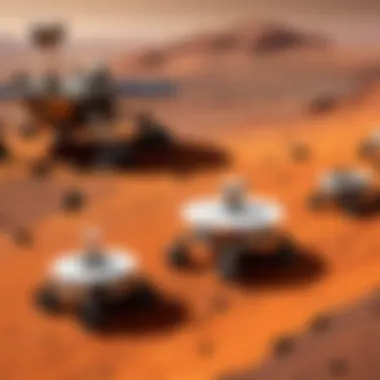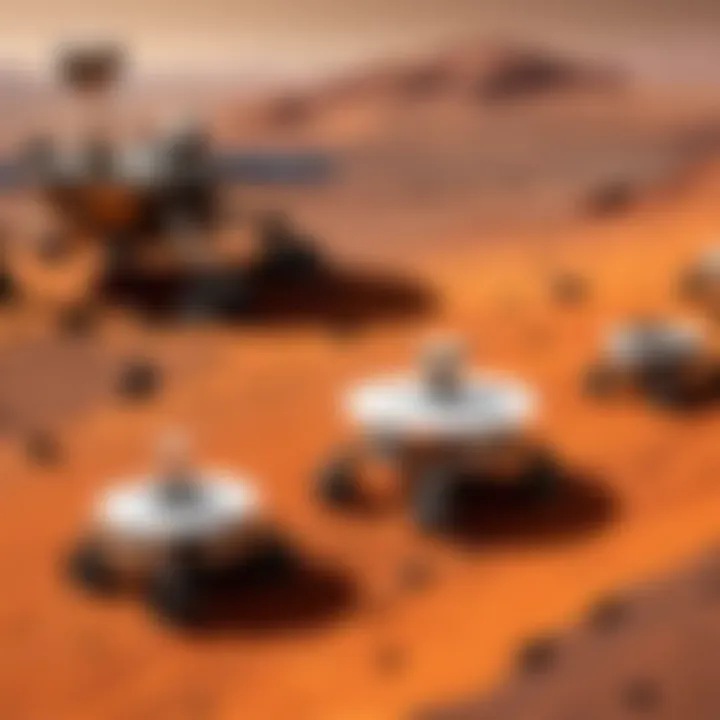Exploring Venus and Mars: A Comparative Study of Two Worlds


Intro
The universe has always held a mirror to our aspirations, with Mars and Venus standing out as the closest cosmic neighbors. Each planet, fascinating in its own right, offers a treasure trove of insights about our solar system. In this narrative, we'll embark on a comparative journey to explore the physical characteristics, atmospheric conditions, exploration missions, and the scientific significance of these two starkly different worlds.
The beauty of the cosmos lies not only in its vastness but in the stories each celestial body tells. With Venus, often dubbed Earth’s twin because of its similar size and composition, we confront scorching temperatures and corrosive atmospheres. On the flip side, Mars presents itself in shades of red, with an aura of mystery surrounding its potential for hosting life. This dive into their complexities will shed light on the implications for future exploration and the intricate nature of planetary science.
Let’s peel back the layers and set the stage for a deeper understanding of these planets, beginning with a look into the technological insights that anchor our explorative aspirations.
Prolusion
Understanding the complexities surrounding Venus and Mars is essential for unraveling not just the mysteries of our neighboring worlds, but also the broader questions regarding planetary science and potential life beyond Earth. As we venture deeper into the cosmos, examining the physical attributes and atmospheric conditions of these celestial bodies reveals insights into their histories, compositions, and roles in the solar system. This article will illuminate the contrasting yet complementary natures of Venus and Mars, revealing what they can teach us about astrobiology, habitability, and the future of human exploration.
Understanding Planetary Context
To comprehend the significance of Venus and Mars, it's necessary to place them within the context of our solar system. Both planets, though adjacent to Earth in the cosmic dance, exhibit strikingly disparate environments. Venus, often considered Earth's twin due to its similar size and composition, is wrapped in a dense, toxic atmosphere that creates surface pressures exceeding those found in the crushing depths of the ocean. Meanwhile, Mars, the Red Planet, is often highlighted for its cold desert landscape, a dry environment that bears scars of massive geological processes.
By examining the unique conditions present on these planets, we can better appreciate not only our own planet's fine balance but also the potential for life elsewhere in the cosmos. Understanding their planet-specific conditions sheds light on broader processes. For instance, the thick clouds of sulfuric acid on Venus serve as a stark reminder of greenhouse gas effects, while Mars' sedimentary features hint at a once-water-rich environment, fueling discussions on the potential for past life.
The Role of Venus and Mars in Astrobiology
Astrobiology ventures into the thrilling realm of life and its myriad forms, studying the conditions that might support life not just on Earth, but on other worlds as well. Both Venus and Mars hold pivotal roles in this field. Researchers are increasingly curious about Venus, analyzing its atmosphere for signs of microbial life that could possibly exist in the upper cloud layers where conditions might be more temperate compared to its boiling surface.
On the other hand, Mars has become a prime candidate in the search for past life. With its ancient river valleys, lake beds, and signs of water activity, the Red Planet invites speculation about organisms that may have thrived long ago. For instance, the presence of perchlorates in Martian soil suggests that some chemical cycles could support microbial life even today, albeit in very different conditions compared to Earth.
By exploring the astrobiological implications of both planets, we not only broaden our understanding of life’s requirements and adaptability but also lay the foundation for future explorations aimed at unlocking the secrets buried deep in the sands of Mars or the clouds of Venus.
"The search for extraterrestrial life is both a scientific endeavor and a philosophical one, challenging our understanding of life in the universe."
Physical Characteristics of Venus
Understanding the physical characteristics of Venus enriches our perspective on planetary science and astrobiology. Venus, often called Earth’s twin due to its similar size and proximity, presents an entirely different environment. A detailed look at its physical features informs us about planetary evolution, geological processes, and atmospheric dynamics which might be applicable to other celestial bodies, including Mars.
Surface Composition and Geography
Venus boasts a surface marked by extensive volcanic plains, vast mountain ranges, and impact craters. The plains, primarily composed of basaltic rock, hint at a history of volcanic activity. When scrutinizing the surface, one finds that around 80% is covered by volcanic material. This leads to important questions regarding the planet's geological evolution. The presence of vast volcanic structures such as Maat Mons, which towers about 8 kilometers high, showcases the tectonic activity that may be more prevalent than previously thought.
Interestingly, Venus lacks the significant plate tectonics found on Earth, leading to an accumulation of heat and pressure, which in turn fuels volcanic processes. The geography of Venus thus reflects havoc of a different kind, illustrating a landscape shaped by cataclysm rather than gradual change. Enhanced imaging from missions like Magellan have provided insights not only into the topography but also into the geological history of this fiery planet.
Volcanic Activity
The volcanic activity on Venus has long been a topic of intense study. This planet may very well still be volcanically active today, which is momentous for its geological narrative. Studies suggest that Venus experiences lava flows and possibly even explosive eruptions, seen in features such as the pancake domes that appear volcanic in origin.
By investigating this aspect, researchers gain vital understanding of planetary processes that also affect Earth's geology. The sheer scale and diversity of volcanic formations on Venus can offer clues about the planet’s thermal history. One captivating detail is the presence of large shield volcanoes, akin to those in Hawaii, but on a grander scale. This raises questions about how Venus manages internal heat and the implications for its atmospheric conditions as well.
Atmospheric Conditions
Atmospheric scrutiny reveals that Venus is shrouded in an incredibly thick blanket of clouds composed mostly of carbon dioxide, with clouds of sulfuric acid. This makes it one of the hottest planets in the solar system, with surface temperatures averaging about 467 degrees Celsius. The atmospheric pressure at the surface is about 92 times that of Earth, roughly equivalent to being a kilometer underwater.
The corrosive nature of the atmosphere also contributes to its inhospitable reputation. Notably, the extreme conditions suggest that if life were to exist here, it would be vastly different and possibly adapted to enduring these harsh environments. Moreover, a comparative lens helps to understand how Mars, with its thinner atmosphere and cooler temperatures, diverges significantly from Venus. This stark contrast prompts questions about the evolution of atmospheres on celestial bodies and the potential for life, making the study of Venus indispensable in comparative planetology.
The physical characteristics of Venus challenge our understanding of planetary formation and sustainability, emphasizing how environment shapes potential for life.
In summary, delving into the physical characteristics of Venus is not just an academic exercise; it transforms our understanding of not just Venus itself, but of planetary science as a whole. As we glean insights from Venus, we refine our models for habitability, geological wonders, and the tools needed to explore other worlds like Mars.
Physical Characteristics of Mars
Understanding the physical characteristics of Mars is crucial for grasping its potential for life and its similarities and differences when lined up against Venus. Each of Mars' unique attributes demands attention, not only because they reveal the planet's history but also because they inform how future explorations could unfold. From ancient riverbeds to the enormous volcano Olympus Mons, every detail offers tantalizing clues about what has transpired on the Martian surface and what might await future explorers.


Geological Features and Landforms
The geological features of Mars paint a vivid picture of a planet once vibrant with activity. With the largest volcano in the solar system, Olympus Mons, standing three times the height of Mount Everest, Mars certainly commands respect. This shield volcano symbolizes not just size but the rich volcanic history of the planet. Researchers believe that the caldera of Olympus Mons likely formed through a series of eruptions over millions of years. Not too far off, the Valles Marineris canyon system slices the Martian surface wide open, stretching over 4,000 kilometers. Its sheer scale hints at tectonic movements and erosion processes that shaped the planet.
Additionally, the mundanely named Martian dunes can be spectacles in their own right. They shift, grow, and recede with the Martian winds, offering a glimpse into the planet’s climatic variations. Understanding these features lays the foundation for future studies on how Mars, a once-thriving hypothesis for life, has been altered over time.
Water Presence and History
When we evoke the image of Mars, visions of red dust often come to mind. Yet, water—that elixir of life—holds a significant role in Mars' saga. Evidence suggests that liquid water flowed on the Martian surface billions of years ago. When researchers stumbled upon the remnants of ancient riverbeds and lakes, it set off a cascade of questions about how life may have thrived in those primordial waters.
In particular, the discovery of recurring slope lineae—dark streaks that appear to ebb and flow with the seasons—hints at briny water's transient nature, potentially capable of sustaining microbial life deep beneath the surface. The presence of ice, particularly at the poles and beneath the regolith, further underlines this history of water. It’s a reminder that while the planet may appear desolate now, there are signs that tell a story of what came before.
Atmospheric Analysis
One cannot discuss Mars without a nod to its atmosphere. Thin and tenuous—about 1% the density of Earth’s atmosphere—Mars offers an environment that's challenging. It’s mainly composed of carbon dioxide, with trace amounts of nitrogen and argon. This composition contributes to its notorious climate, which swings from frigid winters to scorching summers, with dust storms that can envelop the planet for weeks at a time.
However, what really catches the eye are the seasonal changes observed on the Martian surface, particularly through imaging satellites. These observations show how frost develops and sublimates, indicating complex systems at play. Furthermore, understanding the Martian atmosphere is not just about looking at what is; it’s about envisioning what could be possible. Manipulating and terraforming Mars’ atmosphere could one day transform the planet into a more habitable world.
"The investigation of Mars not only stretches our understanding of our solar system but also triggers monumental philosophical implications about life beyond Earth."
As we progress into future exploration, the physical characteristics of Mars become not just points of interest but repeating themes in an unfolding story about what it means to seek out new worlds. Each feature invites us to reconsider familiar paradigms and encourages out-of-the-box thinking on habitability and exploration.
Comparative Analysis of Atmospheres
The atmospheres of Venus and Mars play a pivotal role in understanding the potential for life, climate dynamics, and future exploration of these planets. Each planet’s atmospheric composition and structure impact surface conditions and influence any chance for habitability. This analysis not only highlights stark differences but also sheds light on the significance of atmospheric studies in planetary science.
Temperature Extremes
Both Venus and Mars experience extreme temperature variations that shape their environments in unique ways. Venus, often dubbed the hottest planet in the solar system, boasts surface temperatures averaging around 475°C (about 900°F). This intense heat is a result of a thick atmosphere rich in carbon dioxide that generates a runaway greenhouse effect, trapping heat like a warm blanket.
In contrast, Mars experiences much cooler surface temperatures, typically around -80°F (-62°C) at the equator during winter nights. However, temperatures can plummet to as low as -195°F (-125°C) near the poles. The differences are stark, pointing to how atmospheric insulation and composition directly affect temperature.
The study of planetary temperatures reveals much about their geological and potential biological history.
Chemical Composition
The chemical makeup of the atmospheres reveals vital clues about the planets’ past and present conditions. Venus’s atmosphere consists of approximately 96.5% carbon dioxide, with clouds composed mostly of sulfuric acid. This concoction contributes not only to its high atmospheric pressure, about 92 times that of Earth, but also to extreme acidity, making it a hostile environment for life as we know it.
Mars, by contrast, has an atmosphere that is exceptionally thin, composed of about 95% carbon dioxide, but with only trace amounts of oxygen and water vapor. The thinness makes it incapable of retaining heat effectively, leading to drastic temperature swings. This aspect of Martian atmosphere raises intriguing questions about past water presence and potential microbial life that might have thrived during its warmer epochs.
Weather Patterns
Weather on Venus is characterized by relentless clouds and storms that can create wind speeds of up to 360 km/h (224 mph) in the upper atmosphere. However, these winds don't translate to significant surface weather due to the planet's superheated surface and continuous weather systems dominated by stagnant air masses.
In contrast, Mars has seasons akin to Earth’s, albeit more extreme. It experiences dust storms that can envelop the entire planet, dramatically affecting visibility and temperature. The research into Martian weather patterns provides insights into its climatic history, shedding light on possible water activity in the ancient past. Furthermore, understanding these atmospheric phenomena can inform future missions, particularly concerning landing and exploration strategies.
Habitability and Life Potential
The notion of habitability plays a pivotal role in our understanding of planetary science, particularly when comparing Venus and Mars. Each planet presents a unique puzzle regarding the conditions necessary for life, which raises several intriguing questions about their environments and potential to harbor life, past or present.
Venus: A Harsh Environment
When one thinks of Venus, descriptions often veer towards extreme. The surface of this planet is like an oven, with temperatures soaring to a blistering 464 degrees Celsius. This relentless heat is complemented by a thick atmosphere, composed primarily of carbon dioxide, with clouds of sulfuric acid cloaking the landscape. Such conditions seem utterly inhospitable to life as we know it. Outdoor excursions would be akin to a trip through hell itself.
Despite these harsh realities, researchers speculate about the potential for microbial life within the upper atmosphere. At about 50 kilometers above the surface, temperatures drop to a more manageable degree, hovering around 30 degrees Celsius. In this layer, the atmospheric pressure is comparable to that of Earth, making it a fascinating area for study. Proponents of the idea muse that if life exists on Venus, it might take on bizarre forms, adapted to conditions we can scarcely imagine. These ideas are not merely whimsical flights of fancy but rather grounded in scientific exploration, seeking evidence of potential biological activity despite the hostile ground below.
Mars: Signs of Past Life


In the case of Mars, the narrative shifts from a picture of hostility to one of optimism. While today's Mars is a chilled desert, evidence abounds suggesting it once harbored liquid water and, by extension, conditions that could support life. Features like river valleys and polar ice caps provide tantalizing clues about the planet's watery past.
Exploratory missions reveal minerals known to form in water, and Martian rovers like Curiosity and Perseverance are kicking up more than dust—they're unearthing hints of ancient microbial environments. The potential for ancient Martian life has captivated scientists and enthusiasts alike, contributing to the hypothesis that microbial ecosystems might have thrived billions of years ago.
Recent findings, such as those suggesting Martian soil has organic compounds, only fuel speculation about life on the red planet. Though current conditions are extremely harsh, with temperatures reaching -125 degrees Celsius during winter and thin atmosphere not holding precious water effectively, the mere idea of life once existing sends ripples through the scientific community.
"If life ever existed on Mars, it opens pathways to understanding the evolution of life as a universal phenomenon, rather than an Earth-centric one."
In summary, while Venus presents an environment that seems hostile to life now, pockets of hope exist in its atmosphere. Conversely, Mars, which bears the scars of a drier history, holds significant evidence hinting that it may have been a cradle for life in its prime. Both planets tell a complex story of their own habitability and continuously drive the quest for knowledge beyond our blue planet.
Historical Exploration of Venus
Understanding the historical exploration of Venus is crucial for grasping not only the evolution of planetary science but also how we’ve expanded our horizons in terms of our cosmic neighborhood. This exploration provides key context to the ongoing discussions about the potential for life elsewhere and advances in technology.
Notable Missions
The pursuit of knowledge about Venus began in earnest during the Space Age, with several missions marking important milestones. Among the notable missions:
- Mariner 2: Launched by NASA in 1962, Mariner 2 became the first spacecraft to perform a successful flyby of Venus, returning valuable data about its surface temperature and atmosphere.
- Venera Program: The Soviet Union’s Venera missions were groundbreaking. Venera 7, which landed on Venus in 1970, was the first spacecraft to transmit data from the surface of another planet. This mission provided insights into the harsh conditions, revealing the extreme pressure and temperature on Venus.
- Magellan: Launched in 1989, Magellan used radar to map 98% of Venus’s surface. It discovered unique geological features, such as large volcanic fields and vast highland regions, enhancing our understanding of Venus’s topography.
- Venus Express: The European Space Agency’s mission from 2006 to 2014 studied the atmosphere and provided a glimpse into weather patterns on Venus. Notably, it revealed the planet's thick clouds of sulfuric acid, challenging previous notions about its weather system.
These missions not only painted a vivid picture of Venus but also set the stage for future explorations. As technology progressed, so did our understanding of this enigmatic planet. Each mission contributed a piece to the puzzle, showcasing Venus’s rugged landscape, dense atmosphere, and relentless surface conditions.
Findings and Innovations
The exploration of Venus has led to significant findings and innovations in planetary science. Key breakthroughs include:
- Atmospheric Composition: Missions revealed that Venus has an atmosphere composed of approximately 96% carbon dioxide, with traces of nitrogen, sulfur dioxide, and water vapor. This information has implications for understanding greenhouse gas effects and climate.
- Surface Features: Radar mapping from the Magellan mission uncovered that Venus is predominantly basaltic, featuring vast volcanic plains, large shield volcanoes, and interesting tessera terrains, which indicate tectonic activity.
- Climate Studies: Venus Express’s observations prompted scientists to reevaluate the planet's atmospheric dynamics. The findings suggested the presence of super-rotating winds, which move much faster than the planet itself, offering insights into atmospheric behavior in extreme conditions.
"The pursuit of understanding Venus not only enriches our knowledge but also underscores the importance of innovation in space exploration."
The discoveries and advancements that emerged from these missions have laid the groundwork for future exploration efforts, urging us to think critically about the potential for life and habitability beyond Earth. The journey to unveil the secrets of Venus continues to inspire researchers and technologists alike, emphasizing the multifaceted relationship humanity has with its planetary neighbors.
Historical Exploration of Mars
Mars has captivated human imagination for centuries, and its exploration reflects our quest for knowledge about our neighboring planets and the wider universe. Understanding the historical exploration of Mars is crucial in this article, as it sheds light on humanity's evolving relationship with this red planet. The significance is not just in the discoveries made, but also in what these findings tell us about our own planet and the potential for future colonization.
Key Missions and Discoveries
The journey of Mars exploration can be traced back to the late 1960s with missions that marked monumental strides in our understanding of the planet. Here are some of the key missions and their landmark discoveries:
- Mariner 4 (1965): This was the first successful flyby of Mars, providing human beings with the first close-up images of the planet. The pictures revealed a cratered landscape, which challenged the notion that Mars might host life.
- Viking 1 and 2 (1976): These were the first spacecraft to land on Mars. They conducted extensive experiments on the surface to identify signs of life, leading to more questions than answers about Martian geology and biology.
- Mars Pathfinder (1997): Not just a lander, it carried the Sojourner rover, the first robot to explore the Martian surface. It successfully analyzed rocks and soil, providing valuable data about the planet's composition and climate.
- Mars Exploration Rovers: Spirit and Opportunity (2004): These twin rovers are famous for their longevity and scientific yield. Each made significant findings, such as evidence of past water, showcasing that Mars may have been more Earth-like than previously thought.
- Curiosity Rover (2012): Continually exploring Gale Crater, Curiosity has sent back a wealth of information about Mars' past, including evidence of ancient habitable conditions, leading scientists to reconsider the planet’s potential for life.
Each of these missions contributed to the growing body of knowledge about Mars, helping to craft a narrative that bridges hope and skepticism regarding Martian colonization.
Future Missions and Ambitions
Looking forward, the ambitions surrounding Mars are nothing short of audacious. As we stand on the precipice of a new era in planetary exploration, several future missions aim to delve deeper into the mysteries of the red planet:
- Mars Sample Return Mission: Jointly planned by NASA and ESA, this future mission aims to bring back Martian soil samples for analysis on Earth, which will provide unprecedented insights about the planet’s history.
- Human Missions to Mars: Both NASA and private organizations like SpaceX are actively pursuing crewed missions to Mars. The long-term vision is not just to visit but to establish a sustainable human presence on Mars.
- Tech Innovations for Exploration: Planned missions will also test new technologies that could aid in exploration, such as autonomous navigation systems and new life-support systems designed for long-duration stays.
In summary, the exploration of Mars has transitioned from simple flybys to complex missions that not only seek to answer questions about immediate survivability but also aim to prepare for human colonization. The stakes are high, and the potential discoveries could rewrite our understanding of life and humanity's place in the cosmos.
"Exploration knows no bounds.The desire to reach beyond the stars mirrors our deepest aspirations."
Through each mission, captured in stories of struggle and discovery, the historical exploration of Mars serves as a testament to humanity's innate curiosity and relentless pursuit of knowledge.
Cultural Impact and Perception


The cultural significance of Venus and Mars stretches far beyond their planetary identities. These celestial bodies have often been personified and mythologized, reflecting human aspirations, fears, and the allure of the unknown. This section explores how each planet influences literature, art, and broader popular culture, providing a lens through which we can understand humanity’s place in the universe.
Venus in Literature and Art
Venus has been a muse for different artistic expressions. The planet's link to love and beauty is largely derived from its namesake, the Roman goddess of love. Throughout history, various works have encapsulated this romantic association. For instance, Botticelli’s masterpiece, "The Birth of Venus," not only illustrates the aesthetic admiration for the planet but celebrates feminine beauty and purity in a classical context.
In literature, Venus often symbolizes unattainable love or desire. Poets, such as John Keats and William Blake, reference her to frame themes about longing and beauty. These allusions provide deeper insight into a cultural narrative that entwines desire with the natural world. Furthermore, Venus represents not just beauty but also conflict; one could argue that the planet's harsh environment is a metaphor for the tumultuous nature of relationships—glamorous yet perilous.
Venus also appears frequently in modern pop culture. Think about the use of the planet in songs, advertisements, and even video games. These references serve not only as artistic expressions but also as cultural artifacts that reflect shifting societal norms around love, passion, and femininity.
Mars and Popular Culture
Mars, by contrast, has captivated the human imagination as a symbol of war, best represented in the mythological figure Mars, the god of war. This martial imagery has found its way into literature, notably in H.G. Wells’ "The War of the Worlds," where Martian invaders encapsulate humanity’s fears about conquest and existential threats.
In contemporary settings, Mars has become a focal point in science fiction. Films such as "The Martian" and series like "The Expanse" draw on the planet's desolate landscapes and potential colonization, sparking current debates about technology and humanity's future. Mars is portrayed often as the next frontier—a stark contrast to Earth, yet tantalizing for its potential.
"Mars is the ultimate representation of the untamed. It is an echo of what humanity might become and achieve—or ruin and destroy."
Moreover, Mars has been depicted in video games, sports team names, and tech products, weaving its image into various layers of culture. The frequent references elevate Mars from mere curiosity to a potent symbol of our ambitions and challenges as we stretch our imagination toward possible interplanetary existence.
To summarize, Venus and Mars not only enrich our understanding of planetary science but also shape cultural narratives in significant ways. The portrayal of these planets tells us much about humanity’s emotional landscape and intellectual aspirations. Whether in literature or popular culture, these celestial bodies inspire us to dream and ponder our place in the universe as we look toward the stars.
The Future of Interplanetary Exploration
Interplanetary exploration stands as a beacon of human curiosity and ingenuity, driving us toward an understanding of not just our solar system but also our place in the cosmos. With missions to Venus and Mars, the scientific community is poised to uncover significant insights that could alter our understanding of planetary science as we know it. This section will delve into the essence of the future exploration, looking at specific goals tailored for human amiability and the technological marvels required to metamorphose those desires into reality.
Human Exploration Goals
The spotlight on human exploration reflects a growing desire to not just send robotic agencies but actual people into the great unknown. Becoming interplanetary is no longer just a dream; it’s a meticulous plan taking shape. Space agencies like NASA, ESA, and private entities strive to expand mankind’s reach beyond Earth.
Key objectives for upcoming missions focus on:
- Establishing Human Presence: Initiatives like sending humans to Mars within the next couple of decades aim to establish a permanent base, paving the way for future colonies. This requires not only transportation solutions but also sustainable life-support systems.
- Scientific Research: Scientists wish to investigate whether microbial life could still exist in the clouds of Venus or if fossils exist in Martian soil. Such research underpins the search for life beyond Earth and deepens astrobiological understanding.
- Technological Development: Developing habitats that can withstand extreme atmospheric conditions becomes crucial. For instance, the vintage of spacesuits specifically designed for different terrains and climates illustrates forward-thinking.
- International Collaboration: Partnerships across countries can maximize resources and expertise. By pooling talent and equipment, exploration endeavors become more efficient and innovative.
These objectives showcase a collective human ambition which is galvanizing both space agencies and private sector players alike.
Technological Innovations Required
For aspirations of human travel and sustainable living on another planet, the need for innovative technologies cannot be overstated. Overcoming the hurdles of distance, environment, and psychological well-being during long-duration spaceflight demands unprecedented solutions.
Essential technological advancements include:
- Advanced Propulsion Systems: Current rocket technology may take months to reach Mars. New concepts, such as nuclear thermal propulsion, could change that narrative significantly, shortening travel time and potentially increasing mission effectiveness.
- Life Support Systems: This is a make-or-break factor for human exploration. Creating closed-loop life support systems that recycle air, water, and waste efficiently ensures safety and sustainability.
- Radiation Protection: Space travelers face severe radiation, particularly beyond the Van Allen belts. Innovations in shielding could protect crews during interplanetary missions from cosmic rays and solar particles.
- Robotic Assistance: Before humans arrive, robots will play a key role in setting up infrastructure. Whether it’s developing habitats from local materials or scouting for water sources, pre-deployed robotics will be essential for ensuring safety and productivity.
The marriage of these technologies will play a pivotal role, transitioning theoretical concepts into actionable blueprints for interplanetary living.
"The future is not some place we are going, but one we are creating."
– John Schaar
Finale
The journey through the complexities of Venus and Mars reveals crucial insights about our neighboring worlds. Both planets serve distinct roles in our understanding of planetary science, highlighting the wonders and challenges of extraterrestrial exploration. The exploration efforts undertaken thus far have laid a vital foundation, allowing us to better appreciate the environments, histories, and potential for life on these two planets.
Summary of Insights
In examining the different characteristics of Venus and Mars, one can't help but notice the polar opposites they present. Venus's dense atmosphere, laden with carbon dioxide and sulfuric acid clouds, creates a greenhouse effect so fierce that surface temperatures soar to about 900 degrees Fahrenheit. It’s a veritable inferno where life as we know it struggles to exist. On the contrary, Mars, with its thin atmosphere composed mainly of carbon dioxide, has shown signs of a more welcoming past, where liquid water could have flowed freely across its surface. This key difference plays a significant role when scientists ponder the habitability factor of these planets.
The historical missions to both planets have expanded our horizons. Each spacecraft that has passed or landed contributed pieces to the ever-expanding puzzle of their geological and atmospheric make-up. From the Venera program's groundbreaking Venusian landers to NASA's Perseverance rover scouring Martian terrain, these endeavors enrich our understanding of potential past and present life forms.
Future Perspectives
Looking ahead, the future could hold exciting possibilities for both worlds. The exploration landscape is robust, with missions like NASA's DAVINCI+ aiming to unravel the mysteries of Venus's atmosphere, while the prospect of human missions to Mars fuels our imagination. The collaborations between national space agencies and private companies hint at a golden age of exploration on the horizon.
Continued research and technological advancements will be integral in overcoming existing challenges, such as launching durable probes capable of withstanding Venus's extreme conditions or developing sustainable life-support systems for Martian habitats. As more discoveries emerge, the narrative of both planets entwines with the story of humanity's quest for knowledge, challenging us to reconsider not just our place in the solar system but the potential relationships we could foster beyond Earth.







